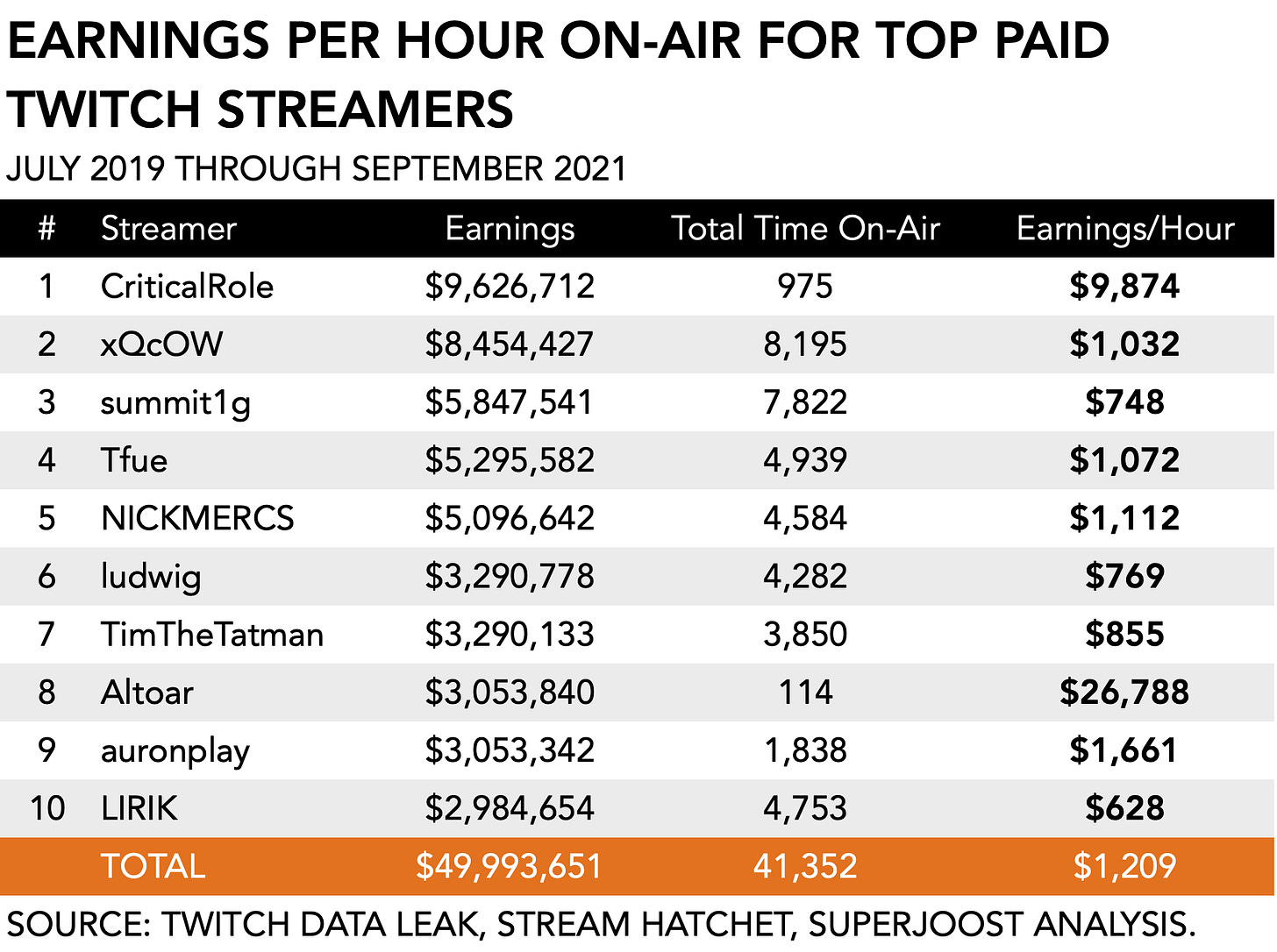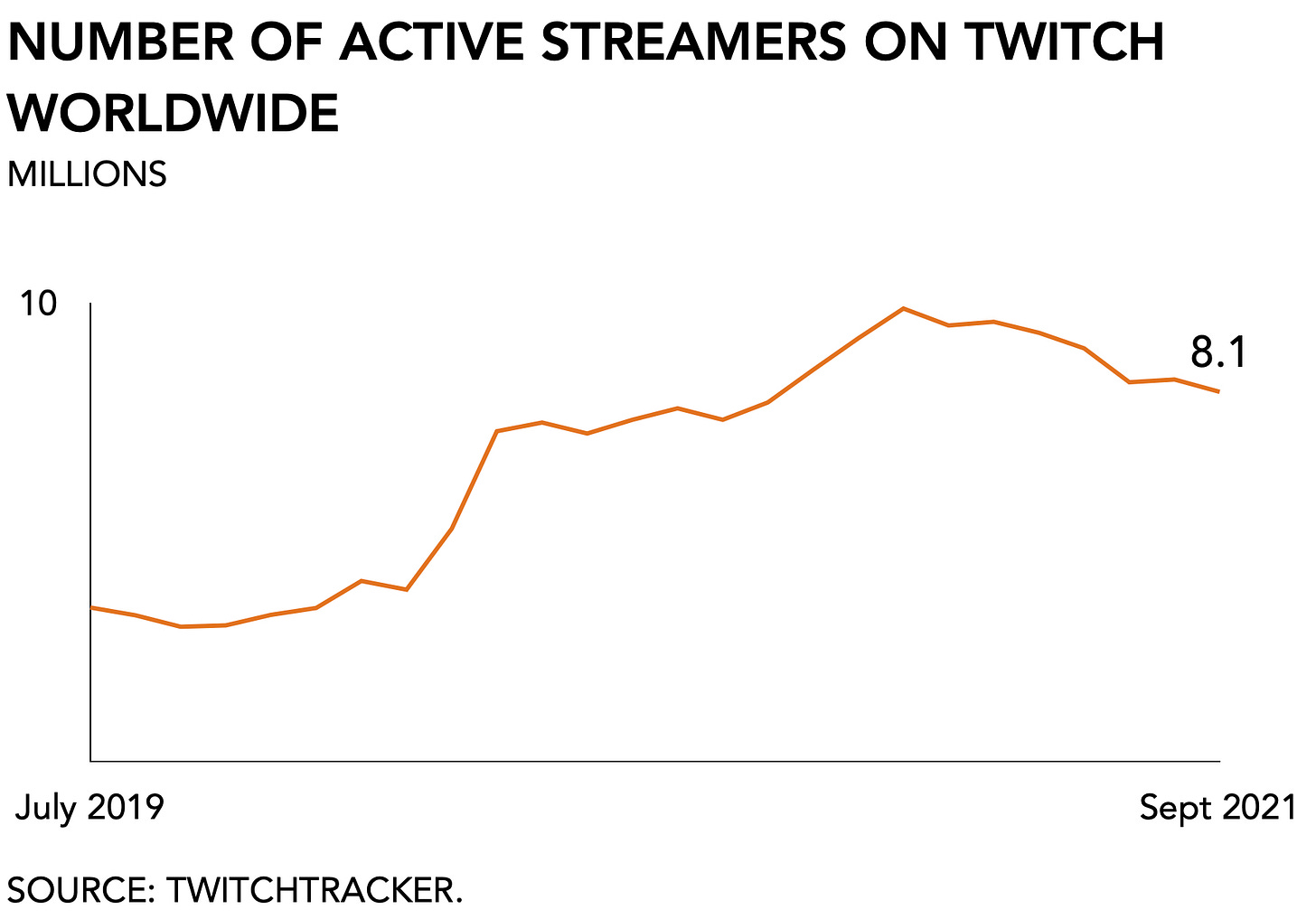The unbearable lightness of streaming
Deep-dive on Twitch data and its economics
Last weekend I spent rummaging through the juicier parts of the leaked Twitch data. It created quite a stir.
Almost as soon as the leak started to spread did the data find its way onto social media and news outlets. The WSJ did an excellent job summarizing the roughly two years of streamer payout data to illustrate the rapid growth of Twitch.
An immediate observation is that absence of any cyclicality. Rather it is up and to the right. Its most recent data point, September 2021, shows a total monthly payout of $102 million, up +42 percent from $71 million a year ago, and +179 percent from $37 million in September 2019. For the period January through September, Twitch paid out $519 million last year compared to $889 million (+71%) in 2021.
Those are healthy growth numbers. And with a monthly average of $100 million, it is not a stretch to assume that Twitch is going to spend over $1 billion in streamer payouts in 2021.
The data leak also reinvigorated the discussion around who gets paid what, and why is it mostly men? Only as the 39th highest-earning streamer do we find a first woman (Pokimane). The vast majority of the top streamers are also white and, as Eurogamer points out, “don’t (publicly) identify as part of the LGBT+ community.”
Hm.
So much for ‘everyone’s a gamer now.’ In fact, for all the talk about women playing games as much as men, FWIW, there are only 3 women in the top 100: Imane “Pokimane” Anys, Kaitlyn “Amouranth” Siragusa, and German music streamer Sintica.
Another discussion erupted around the payouts focused on whether streamers make too much. One industry icon, Cliff Bleszinski, expressed discontent because “it upsets me that so many are making WAY more money than most of the GAME DEVELOPERS THAT MADE THE GAMES THEY STREAM,” which he quickly followed up with “I'm not saying I don't hate that content creators can make BANK - good for them - I just want devs to get paid more, ffs.”
A nuanced debater the rest of the time, I’m sure, Bleszinski points to what he believes are high payouts. He’s also wrong.
In some case streamers received donations from audience members with the message “you need it more than I do.” With 25 percent of the 10,000 top earners on Twitch making less than minimum wage, that seems appropriate. There exists an enormous discrepancy between the top 1% and everyone else in terms of revenue. Some of this has been the focus of previous study. A 2020 study titled Do Larger Audiences Generate Greater Revenues under Pay What You Want? Evidence from a Live Streaming Platform" showed “a mostly positive casual effect of audience size on tipping revenues” which is consistent with the power curve we generally see in entertainment.
Millions of dollars in revenue for kids broadcasting from their bedrooms may seem high. But that is a poor man’s perspective on what’s involved in streaming. Let’s break it down.
To earn its $9.6 million for the period July 2019 through September 2021, CriticalRole was on-air for a total of 975 hours. (Thanks StreamHatchet! Disclosure: I’m an advisor.) Quick maths tells us that the channel generates $9,874 per hour that it is broadcasting.
That’s a whole lot.
Among the top 10, the average number of dollars generated over the entire period per on-air hour is $1,209.
The big secret behind these numbers breaks into two parts. First, based on the leaked data, Twitch doesn’t really pay out that much in ad revenue. On average, streamers receive only around 9% of their total income from ads. That can still run up to a pretty good amount, certainly, but it’s unlikely to be enough for most to financially sustain themselves.
Second, subscriptions account for 56% of revenues. Whoa. The most loyal and most engaged viewers also represent the biggest piece of income. Another 20% comes from Prime subscriptions but, in fairness, those are free to the viewer. It helps explain why we see big differences among streamers is their reliance and emphasis on building an actively engaged user base.
Instead of focusing on volume, streaming lots of hours to get lots of eyeball exposure and tiny ad payments, the more fuel-efficient streamers have a defensible strategy or clever programmatic content. CriticalRole doesn’t really stream that much and focuses on Dungeons & Dragons, which is an evergreen but by no means the latest and greatest. But it is a dedicated audience base that is deeply engaged. Altoar is the biggest German streamer. That means he has impressive influence and role as a gatekeeper on Twitch to the second-largest games market in Europe (Germany). In Spain, auronplay is one of the top streamers.
Streaming economics
The economics of live streaming are bit like being a pilot. You really only get paid while you’re flying the plane. For the best-paying airlines, Alaska Airlines, the most senior pilots earn $266 per hour. The same applies to adjunct faculty at universities, where you get paid based on so-called “contact hours” (i.e. the time you spend in front of a classroom), which amounts in my experience to about $370 per hour. Both of these jobs require years of training and practice, of course, and a hefty upfront financial investment (aka student loans).
Streamers, too, do a lot of work off-camera. According to a recent study titled Behind the Streams: The Off-Camera Labour of Game Live Streaming that based its findings on a 100 interviews with streamers over the course of a 2-year period, time spent behind the scene breaks into four distinct categories.
With 8.1 million active streamers on Twitch in September, it is impossibly difficult to stand out. Marketing is the first major off-line activity among streamers. It is an affordances of digital entertainment, of course, that the lowering of entry barriers has resulted in a deluge of content creators. It’s simply not enough to just be on Twitch, and streamers refer this part of the work as “social media management.” It entails spending hours on other, adjacent social networks (e.g., Twitter, Discord) to drive traffic to the Twitch site.
Relatedly, developing a unique visual style is a second key component. This includes creating a proprietary ‘overlay’ (the graphics that frame the broadcast), iconography and other visual elements that constitute a unique digital identity. Successful streamers are quite crafty at this. For instance, Pokimane’s use of a green circle around her profile image immediately distinguishes her from other channels.
A third component involves networking. A big part of live streaming means being available to others. That can vary from networking with other, rivaling or allied, channels. The value for streamers, according to the study, lies in “a strong community being essential to a financially viable stream.” Content creators often spend time in other people’s streams to maintain and boost visibility, cater to fans with similar interests, and stay on top of what goes on in the broader community.
Finally, it is easy to overlook the fact that all businesses have demanding administrative tasks. The fourth category of off-camera labor involves involves corresponding with providers and partners, managing channel moderators, and developing relationships with sponsors.
The argument, in short, that streamers make a lot of money doesn’t match the data. Even among the top performers, there is a massive amount of work that goes into each hour of streaming. CriticalRole’s $10k/hour is naturally split among a group of people and their production team who are all undoubtedly working off-camera. Making money is directly dependent on truly engaging an audience. That is a lot of work. That deserves to be compensated fairly.
More generally, Twitch’s massive growth, the wide spread in fuel efficiency among streamers, the lop-sided revenue streams, and the substantial amount of off-camera work that is required to be successful makes live streaming a tough nut to crack. Far from being a cool platform where you can stream your life and connect with worldwide audience, the Twitch data leak characterizes it as a highly competitive, low-paying content economy where the platform holder reigns supreme. Even so, the expectations of live streaming as a viable business have shifted, as, according to the Economist, video games have become a spectator sport.
As for some negative impact on Twitch or mothership Amazon, I don’t see that happening. The internet has seemingly moved on already. However, I do expect the data to show up across a wide range of studies. One happy outcome would perhaps be the a more balanced information environment. Platform holders hold an advantage over complementors because they know how much everyone else is making and you, as a content creator, do not. But in a single swoop that veil has now been lifted.
On to this week’s update.
🎙 Quick event note
I had a conversation about blockchain gaming with Jon Jordan who accused me of being the perfect guest. Watch the 44-minute video here.
NEWS
Dapper Labs partners with Chainalysis
With the shortage of talent, the technical fragmentation, and the sky-high expectations around blockchain gaming stands another massive problem: fraude. The trade in non-fungible tokens has exploded and subsequently attracted a whole host of shitty people. Or as the Verge phrased it: “The NFT scammers are here.”
Nothing will kill the appetite of mainstream consumers and investors faster than a novel technology riddled with the type of problems causing either of them to lose their hard-earned money. To counteract the inevitable, Dapper Labs announced its partnership with Chainanalysis to better monitor activity and transactions on Flow, the crypto currency it developed after its success with CryptoKitties clogged up the Ethereum network.
Over the coming months I expect Dapper Labs to announce further partnerships and possibly acquisitions or investments in key industry relationships. Protection of both consumers and its growing array of sports allies means that it’s on the hook to keep things nice, safe, and clean. If you build it, they may come. But you’ll have to build something safe.
Magic Leap raises a mysterious $500 million round
Valued at $2 billion, the VR hopeful has dropped quite a way from its 2019 $6.7 billion valuation. That’s okay. Building businesses is about bobbing and weaving. But I think it is fair to say that Magic Leap then and now continues to be a spectacular failure.
Certainly, there will be some useful and possibly valuable patents floating around. And I do not mean to question the integrity of the team behind it. But large-scale technological innovation needs not just a few billion; it needs hundreds. Imagine electric vehicles a la Tesla raising single-digits billions and not roll out a highly visible marketing campaign of rocket launches and other tomfoolery. When your illustrious founder finds himself and his mother on Saturday Night Life, you are dealing with a shrewd entrepreneur that knows building it and selling it are equally important.
Where Magic Leap failed so far is, quite simply, giving us anything. Where’s the prototype? Where’s version 1.0? Even Zuckerberg’s hokey vision of virtual reality seemed more credible. Instead Magic Leap has long chosen to shroud itself in mystery, continually raising additional funds without releasing anything into the wild, only to finally fall apart. Similar to Quibi—which was hugely over-funded, had blockbuster star power behind it, and was run by one of Hollywood’s legends—no one is sitting around waiting for Moses to come down the mountain anymore. Hardware development, like software, is an iterative process that requires life-fire feedback from the market.
It casts a long shadow over the longer term potential of virtual reality. As a transformative technology it hasn’t arrived in almost four decades despite a string of attempts. The deus ex machina that Magic Leap hints at is played out and overpriced.
Hyper-casual games seriously growing
This week we saw a $50 million series A raise by mobile gaming startup Homa Games. Since its $15 million seed round last February, it managed to double the number of downloads of its games from 250 million to 500 million. This comes just a few weeks after Voodoo, known for Helix Jump, Crowd City, Hole.io or Paper.io 2, acquired Beach Bum, an Israeli game studio that specializes in tabletop and card games. The rapid push into hyper-casual games tells you that we are dealing with economies of scale here. Watch this space become highly profitable while simultaneously being ignored by legacy game designers.
Bank of America releases 141-page report on NFTs
A helpful read for the coming weekend. The bank’s analysts describe the cryptocurrency sector’s $2.15-trillion market capitalization is “too large to ignore,” and estimated that 221 million users globally had traded cryptocurrency or used a blockchain application as of June 2021, up +235% from 66 million in May 2020. BofA now believes “crypto-based digital assets could form an entirely new asset class.”
PLAY/PASS
Pass. After a show of brilliance with Braid, designer Jonathan Blow now busies himself with arguing that Covid-19 was manmade. Bummer.
Play. Netflix’ Squid Game enters the Metaverse. I challenge you to find a shorter sentence with more buzzwords.







